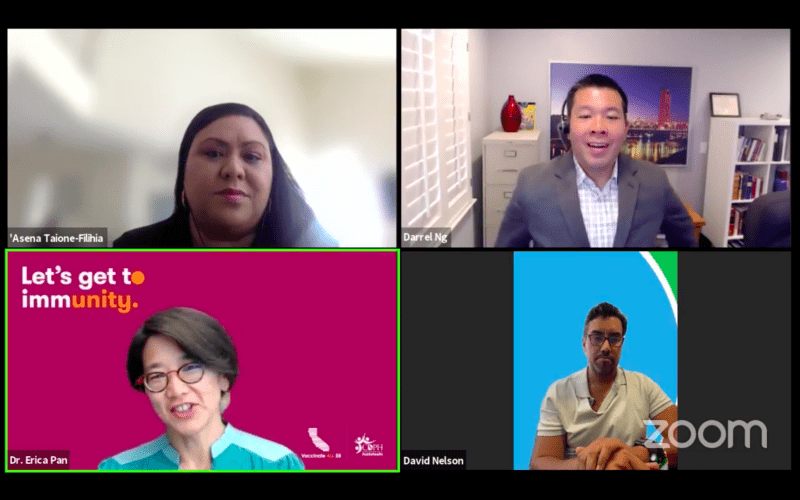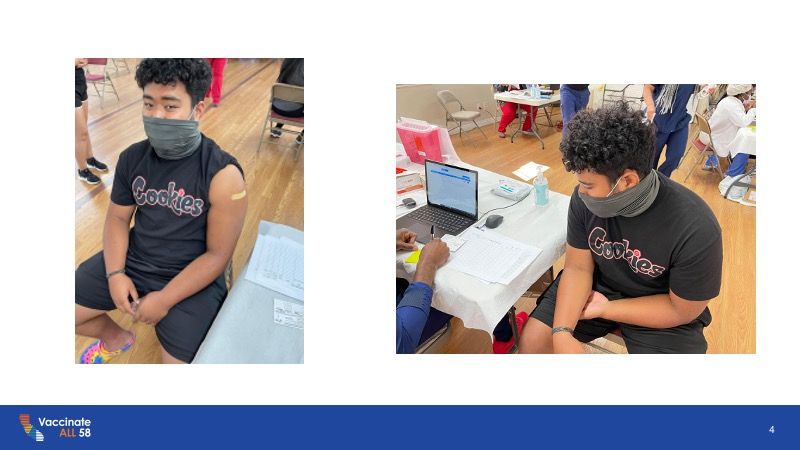Californians Have ‘Met The Moment’ Getting Vaccinated
Screenshot of a slide showing a vaccination in process. (Courtesy: AAPI)
By Sunita Sohrabji, EMS Contributor
Californians have “met the moment” to help save countless lives by getting the COVID-19 vaccine, said Dr. Erica Pan, state epidemiologist for the California Department of Public Health, at a May 3 briefing for AAPI media and community health leaders.
A total of 30 million vaccines have been administered in the state, with 6 million reaching California’s hardest-to-reach communities.
Over 47 percent of Asian Americans in California are fully vaccinated, meaning they have received the two-dose regimen of the Pfizer or Moderna vaccine or the single-shot Johnson and Johnson vaccine. Over 54 percent of the state’s Hawaiian and Pacific Islander population is also fully vaccinated, said Pan, who compared California to neighboring states Oregon and Arizona, which have had slower vaccine rollouts and are experiencing surges in daily new infection rates.
On Jan. 8, California experienced its highest level of new infections: more than 41,000 in a single day, according to data from the Centers for Disease Control. But as more of the state’s residents get vaccinated, the rate of daily new infections has seen steady declines: on May 3, daily new infections in the state had dropped to just 922.
Following a short nationwide pause on the J&J vaccine in April to investigate blood clotting experienced by a small number of women, all three vaccines are now being administered again. Pan provided assurance that all are equally safe and that she chose the J&J vaccine for herself. The Centers for Disease Control recommends women under the age of 50 be aware of the rare risk of blood clots with low platelets after taking the J&J vaccine.

“Cases continue to surge around the world with heartbreaking consequences,” said Pan, mentioning India, where daily infection rates have surged to 400,000, with death rates believed to be about 10,000 per day. “We’re encouraged here in California by the low covid-19 case rates and steady decline in hospitalizations and our increase in vaccinations.”
“It’s important to remember the pandemic isn’t over yet. And as a parent, and a daughter, and a wife, and a public health official specializing in infectious diseases, I encourage everyone to get vaccinated and to encourage your friends and your family to do the same,” said Pan.
“It will help us all get back to hugs, and to the other side of this pandemic,” she added.
Pan discussed the importance of getting the second shot for those who have received the Moderna or Pfizer vaccine. She stressed that there may be mild side effects, such as soreness at the injection site or a mild fever, but recommended Tylenol and plenty of fluids.
Youth 16 and over are now eligible to get vaccinated, and Pan predicted that the FDA will release its review of Pfizer’s data within the month, approving use of the company’s vaccine for children aged 12-15. Moderna and Pfizer will submit their data soon, and Pan noted that by mid 2022, the vaccines should be approved for children above the age of two.
David Nelson, director of public policy at the CalAsian Chamber of Commerce, noted that the economic devastation to California’s 600,000 AAPI-owned businesses will be seen for years to come. He encouraged business owners to tell their employees where to get vaccinated and to give them time off for doing so. The state is set to fully reopen June 15: Nelson advised business owners to open safely and to reach out to the Chamber for help with reopening.


